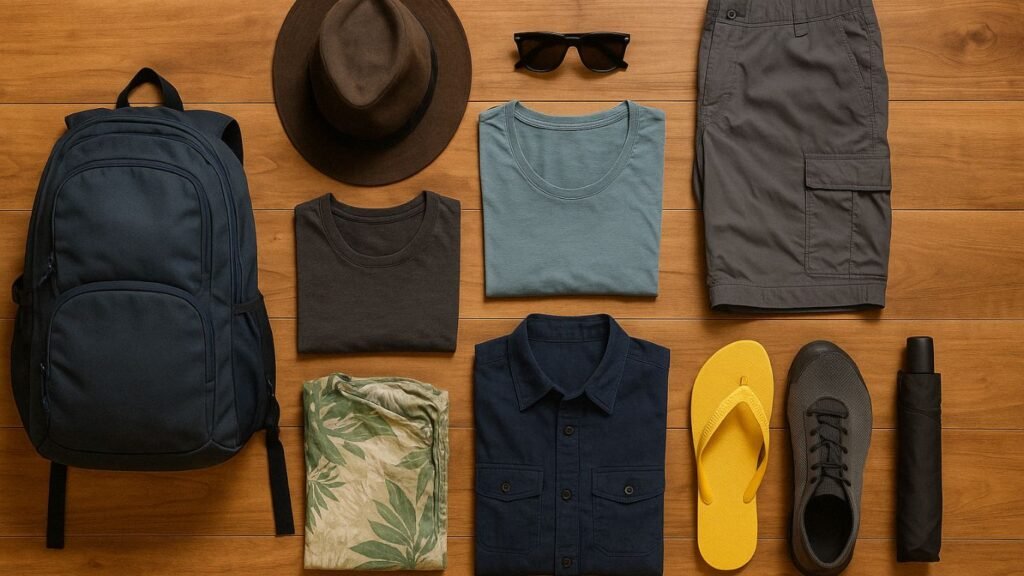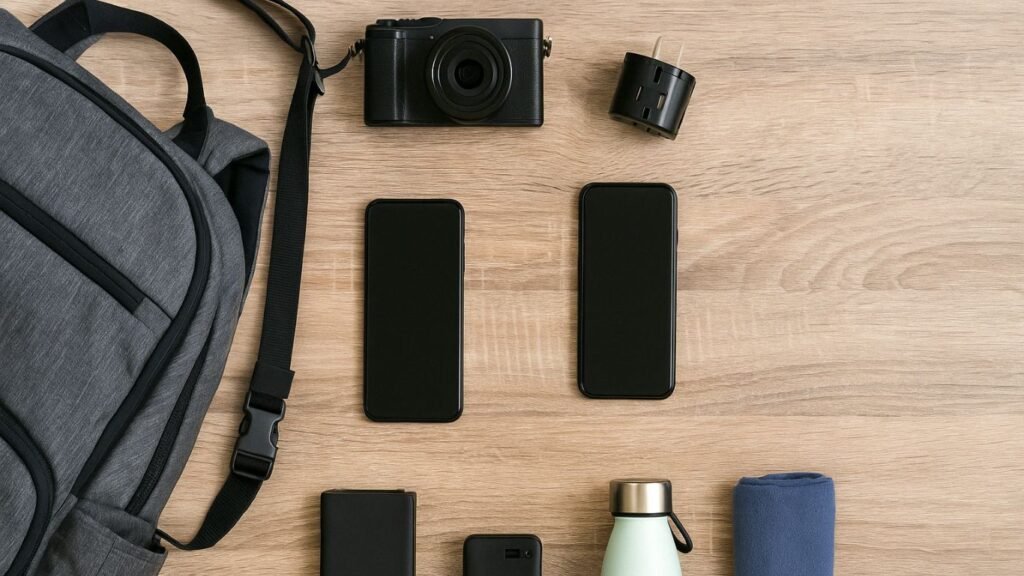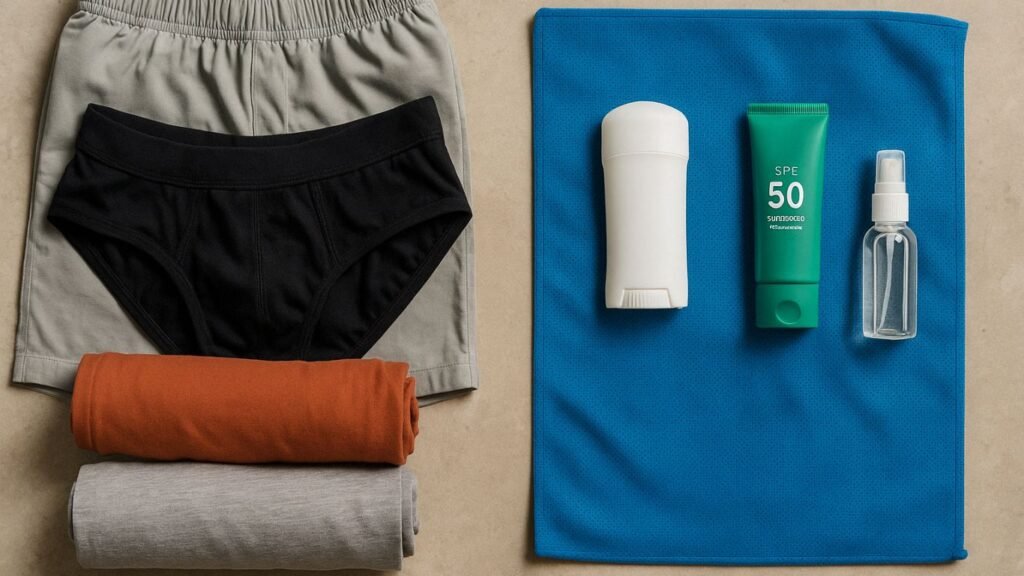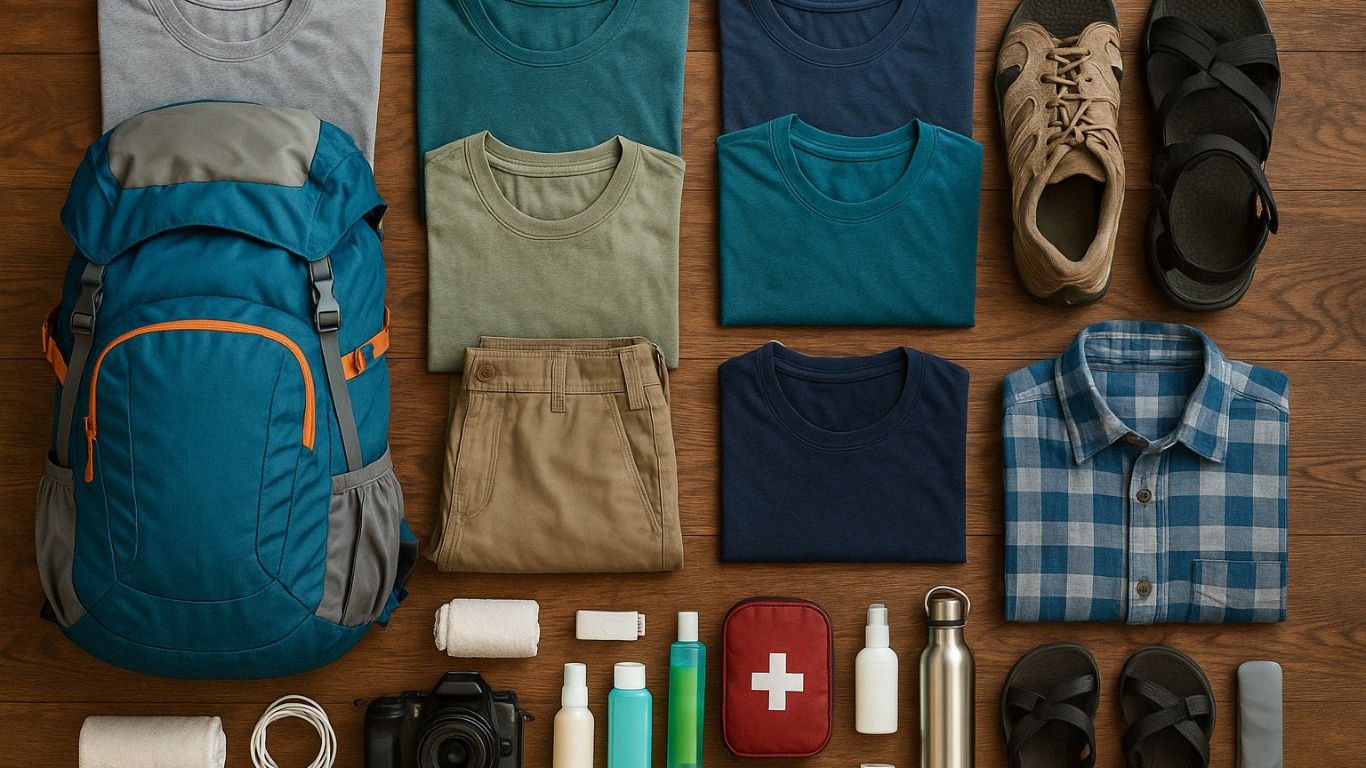Backpacking through Southeast Asia is more than just a journey—it’s a rite of passage for budget-conscious adventurers chasing the thrill of vibrant cities, lush jungles, and remote islands. But to truly savor the spontaneity and freedom of the region, your gear must be carefully curated. That’s where a smart, intentional Southeast Asia backpacker packing list becomes indispensable.
Packing for Southeast Asia isn’t about stuffing your backpack with every item imaginable. It’s about crafting a lean, efficient collection of clothing, gear, and essentials that align with the region’s tropical heat, unpredictable monsoons, and dynamic terrain. From the neon buzz of Bangkok to the serene rice fields of Ubud, every environment presents its own packing challenges—and opportunities.
This guide doesn’t just offer a checklist. It’s a thoughtfully designed Southeast Asia backpacker packing list that’s lightweight, budget-friendly, and sweat-proof—tailored for real travel conditions, from overnight sleeper trains to scooter rides along coastal roads. Whether you’re navigating bustling street food markets or diving into island coves, this packing list ensures you’re ready without being overburdened.
You’ll find detailed recommendations on breathable fabrics, versatile outfits, sweat-resistant toiletries, and compact travel gear that fits a minimalist lifestyle. Along the way, I’ll share personal insights, tested tips, and strategic advice drawn from on-the-ground experience to make your backpack feel like a toolkit—not a burden.
Let’s begin the journey with what to wear, because in Southeast Asia, the right clothing can mean the difference between discomfort and effortless exploration.
Table of Contents
Essential Clothing for Southeast Asia’s Climate

Packing clothing for Southeast Asia isn’t just about fashion—it’s about survival. The region’s sweltering humidity, intense sun, and sudden tropical downpours can turn a poorly packed bag into a daily frustration. That’s why the Southeast Asia backpacker packing list must prioritize function, breathability, and adaptability over everything else.
Lightweight and Breathable Fabrics
Tropical heat demands materials that breathe. Your Southeast Asia backpacker packing list should always include lightweight fabrics that dry fast and resist odor:
- Cotton blends: Soft and breathable, ideal for day-to-day wandering.
- Linen shirts and shorts: Naturally cooling and great for evenings.
- Moisture-wicking synthetics: Ideal for hikes or long travel days.
- Merino wool: Surprisingly effective in hot climates due to its odor resistance.
These fabrics will keep you dry, comfortable, and confident, whether you’re exploring Angkor Wat or bargaining in a Laotian night market.
Versatile Clothing Pieces
Smart travelers don’t overpack—they pack smart. The Southeast Asia backpacker packing list should lean heavily on multipurpose items like:
- Quick-dry t-shirts: Stylish enough for cafes, functional enough for trails.
- Convertible pants: From full-length to shorts in seconds—perfect for temples and treks.
- Sarong or scarf: Functions as a towel, cover-up, curtain, or even a blanket.
- Button-up shirt: Adds polish for nicer dinners while keeping you cool.
Versatile pieces mean fewer items and more space for experiences.
Rain Protection Essentials
In Southeast Asia, rain doesn’t politely knock—it crashes in unannounced. Pack for the inevitable with:
- Packable rain jacket: Lightweight, waterproof, and breathable.
- Dry bag or ziplock set: Protect electronics and valuables from tropical downpours.
- Compact travel umbrella: Easy to stow and essential in cities like Hanoi or Singapore.
Every Southeast Asia backpacker packing list needs rain protection—it’s not optional, it’s critical.
Sun Protection Clothing
Sunburn can derail your trip faster than a missed flight. The sun is relentless, especially near the equator, so armor up with:
- UPF-rated shirts: Built-in sun protection, lightweight, and breathable.
- Wide-brimmed hat or cap: Essential in both cities and jungles.
- Polarized sunglasses: Cuts glare while protecting your eyes.
- Long sleeves and pants: Not just for sun, but mosquitos too.
Proper sun gear keeps you protected, regulated, and ready for long days under a burning sky.
Footwear for Diverse Terrains

When you’re hopping between temples in Cambodia, chasing waterfalls in Laos, or navigating chaotic urban streets in Ho Chi Minh City, the shoes you wear will define your comfort. A well-rounded Southeast Asia backpacker packing list absolutely must include footwear that’s lightweight, versatile, and durable—built for exploration, not exhaustion.
Comfortable Walking Shoes
A solid pair of walking shoes can carry you through winding alleyways, jungle paths, and hours of border crossings. On your Southeast Asia backpacker packing list, this is your day-to-day warrior:
- Trail runners or low-cut hiking shoes: Lightweight yet rugged enough for varied terrain.
- Breathable sneakers: Suitable for cities with the added benefit of being stylish.
- Slip-on mesh shoes: Easy for airport security and hostel dorms.
Your feet are your primary mode of travel—treat them like VIPs.
Sandals or Flip-Flops
No Southeast Asia backpacker packing list is complete without at least one pair of open footwear. The region’s warm temperatures and laid-back lifestyle practically demand it.
- Flip-flops: A staple for beach towns, hostel showers, and quick errands.
- Strap-on sandals (like Tevas or Chacos): Perfect for short hikes, boat rides, and wet markets.
Plus, in many cultures, removing your shoes before entering homes or temples is customary—sandals make that effortless.
Water Shoes (Optional)
For certain adventures—snorkeling in Thailand, cave tubing in Laos, or crossing rivers in Northern Vietnam—water shoes may be worth the space in your bag.
- Lightweight and packable
- Grippy soles for rocky or slippery terrain
- Dry quickly and prevent foot injuries
While not on every Southeast Asia backpacker packing list, water shoes can be a game-changer if your trip leans toward the aquatic or off-the-beaten-path.
Toiletries and Personal Care (Minimalist Approach)

When traveling across Southeast Asia, space is precious—and so is staying fresh in tropical heat. A minimalist approach to personal care is essential for anyone crafting a smart Southeast Asia backpacker packing list. You’ll want your toiletry kit to be compact, effective, and suitable for both urban and off-grid settings.
Travel-Sized Toiletries
In the world of long-haul travel, travel-size is more than a convenience—it’s a philosophy. Choose items that are solid, concentrated, or multi-use. The ideal Southeast Asia backpacker packing list includes:
- Shampoo and conditioner bars: Eco-friendly, long-lasting, and won’t spill in transit.
- Solid deodorant: Compact and TSA-friendly.
- Multipurpose soap: Safe for body, face, and even laundry.
These items lighten your load while keeping you groomed and ready for humid days and hostel mirrors.
Sunscreen and Insect Repellent
Two items you cannot afford to forget: sunscreen and bug spray. The sun is harsh and the insects are relentless. Every responsible Southeast Asia backpacker packing list must include:
- Broad-spectrum sunscreen (SPF 30 or higher): Reef-safe options are better for island stops.
- Insect repellent with DEET or picaridin: Protects against dengue, malaria, and general misery.
- After-sun aloe gel: For the inevitable overexposure.
These aren’t luxuries—they’re survival tools, especially when jungle trekking or island hopping.
First-Aid Essentials
Accidents happen—especially when you’re motorbiking through Vietnam or trekking near Chiang Mai. A basic first-aid kit is an intelligent inclusion in any Southeast Asia backpacker packing list:
- Band-aids and blister pads
- Antiseptic wipes or spray
- Ibuprofen or paracetamol
- Antidiarrheal meds and rehydration salts
Customize your kit based on medical needs, and remember—pharmacies in Southeast Asia are generally accessible, but it’s best to start your journey prepared.
Hygiene Items
Cleanliness can be challenging when you’re sweating by 9 AM and covered in sunscreen by noon. A streamlined hygiene kit helps you stay sharp without overpacking:
- Biodegradable wet wipes: Lifesavers during long bus rides or remote stays.
- Hand sanitizer: Use it liberally, especially before meals or after public transit.
- Menstrual care: Menstrual cups or reusable pads are great low-waste options.
- Toilet paper or tissue packs: Not always provided in public bathrooms.
In a well-balanced Southeast Asia backpacker packing list, personal care doesn’t take up much space—but it has a big impact on your health, comfort, and confidence.
Travel Gear and Electronics

When you’re bouncing between countries, climates, and currencies, the right gear makes everything easier. A reliable set of essentials in your Southeast Asia backpacker packing list ensures you’re ready for long hauls, power outages, spontaneous excursions, and digital nomad duties—all without weighing yourself down.
Lightweight Backpack
The foundation of any well-thought-out Southeast Asia backpacker packing list is the backpack itself. This is your portable closet, storage room, and home base.
Look for:
- Size: 40–50L is ideal for carry-on travel and minimalist packing.
- Structure: Internal frames offer better weight distribution.
- Access: Front-loading (clamshell) designs make retrieving items easier than top-loaders.
- Extras: Padded shoulder straps, lockable zippers, and a built-in rain cover are all worth it.
Your backpack should feel like an extension of you—compact, secure, and built for mobility.
Travel Adapter and Power Bank
Power supply varies across Southeast Asia. Countries like Thailand use Type A and C plugs, while Malaysia and Singapore use Type G. That’s why a universal adapter is a must.
Every serious Southeast Asia backpacker packing list includes:
- Universal adapter with USB ports: One device to charge them all.
- Power bank (10,000–20,000 mAh): Critical during bus rides, border crossings, or overnight trains.
Choose a model with surge protection—rural areas can have unstable power, and you don’t want your gear fried in the process.
Camera or Smartphone
Capturing the vibrancy of Southeast Asia means having a solid device at hand. Depending on your priorities, your Southeast Asia backpacker packing list may include:
- Smartphone with a high-quality camera: Versatile and always within reach.
- Compact or mirrorless camera: For higher resolution, especially for photography-focused travelers.
- Action cam (like GoPro): Ideal for snorkeling, diving, or zip-lining through jungle canopies.
Don’t forget spare batteries, memory cards, and a protective case—especially if you’re heading to wet or dusty areas.
Reusable Water Bottle
A reusable water bottle isn’t just an environmental choice—it’s a backpacking essential. Staying hydrated in tropical heat is non-negotiable, and plastic waste is a growing problem in the region.
The ideal Southeast Asia backpacker packing list features:
- Insulated bottle: Keeps your drink cool all day.
- Built-in filter options: Like GRAYL or LifeStraw for questionable water sources.
Refill stations are common in hostels and cafes, so you’ll save money and reduce waste.
Travel Towel
It might seem like an afterthought, but a microfiber travel towel is one of the most functional items you can pack.
Why it belongs on every Southeast Asia backpacker packing list:
- Quick-drying: Avoids the damp mildew smell in humid climates.
- Compact and lightweight: Takes up a fraction of the space of a normal towel.
- Multi-purpose: Great for beach trips, hostel showers, or yoga sessions.
Choose a towel that comes with a mesh carry pouch—this helps with airflow when packing it away damp.
Documents and Money Matters

Traveling through multiple countries, currencies, and border checkpoints in Southeast Asia requires more than spontaneity—it demands organization. A complete Southeast Asia backpacker packing list goes beyond gear and clothes. It includes essential documentation and financial tools that ensure you stay legal, covered, and cash-ready wherever the road leads.
Passport and Visas
The first and most important item on your Southeast Asia backpacker packing list? Your passport. Make sure it’s:
- Valid for at least six months beyond your return date.
- Not damaged or water-stained, as immigration officers can reject it on sight.
Visa requirements vary across Southeast Asia. Some countries offer visa-free entry for up to 30 days (like Thailand or Indonesia), while others require e-visas or visa-on-arrival. Research your itinerary and print out confirmations when needed. Also, pack:
- Passport-sized photos for visa applications at borders.
- Pen and small folder to keep forms organized.
Travel Insurance
If you can’t afford travel insurance, you can’t afford to travel. From scooter crashes to food poisoning, the risks are real—and costly. A responsible Southeast Asia backpacker packing list must include comprehensive travel insurance.
Look for coverage that includes:
- Medical emergencies and hospital stays
- Evacuation and repatriation
- Theft, lost gear, and trip delays
- Adventure sports coverage (motorbiking, diving, trekking)
Providers like SafetyWing, Heymondo, or World Nomads cater specifically to long-term travelers and backpackers.
Local Currency and Cards
Navigating money in Southeast Asia is a mix of old and new. While cities are becoming more card-friendly, many regions still rely heavily on cash. A strong Southeast Asia backpacker packing list includes:
- Local cash for markets, transport, and small vendors.
- Two bank cards (one as a backup), ideally with no foreign transaction fees.
- Travel wallet with RFID-blocking protection.
It’s also wise to use ATM locators for your bank to avoid hidden fees. Withdraw large amounts at once to limit transaction costs.
Copies of Important Documents
Losing your documents abroad is every traveler’s nightmare. Prevent a crisis by backing up your essentials—physically and digitally.
A thorough Southeast Asia backpacker packing list should contain:
- Printed copies of your passport, visa pages, travel insurance, and ID.
- Digital scans stored securely on Google Drive, Dropbox, or encrypted USB.
- Emergency contact list: Include local embassies, insurance numbers, and bank hotlines.
Keeping a separate pouch or envelope for these copies gives you peace of mind if your main documents are lost or stolen.
Budget-Friendly Packing Tips
Backpacking Southeast Asia doesn’t require an extravagant budget—but it does require strategic planning. A smart, budget-conscious Southeast Asia backpacker packing list is built around quality over quantity, versatility over volume, and smart hacks that keep costs—and your pack’s weight—low.
Choosing Multi-Purpose Items
Multipurpose gear is the cornerstone of every practical Southeast Asia backpacker packing list. Why carry three items when one does the job?
Pack items that perform double or triple duty:
- Buff or scarf: Use it as a sun shield, towel, eye mask, or bandana.
- Convertible clothing: Zip-off pants that turn into shorts, or dresses that double as beach cover-ups.
- Multipurpose soap: One bar for hair, body, laundry, and even dishes.
These essentials save money and space while reducing decision fatigue on the road.
Packing Cubes for Organization
You can pack light—but if it’s disorganized, you’ll still feel overwhelmed. The best Southeast Asia backpacker packing list uses packing cubes not just for space-saving, but for sanity.
Why they matter:
- Separate clean and dirty clothes
- Designate categories (shirts, bottoms, underwear, etc.)
- Compress bulky items like jackets or travel towels
Compression cubes in particular help squeeze down your gear, giving your backpack that always-needed breathing room.
Laundering Clothes on the Go
Laundry services in Southeast Asia are cheap, fast, and easy to find—especially in places like Bali, Chiang Mai, and Hanoi. Instead of overpacking, a minimalist Southeast Asia backpacker packing list embraces laundry as part of the travel rhythm.
Pack a few tools to make this easier:
- Sink stopper: Wash essentials in hostel sinks or basins.
- Travel-sized detergent: Lightweight and effective.
- Elastic clothesline with clips: Hang your laundry almost anywhere—hotel bathrooms, balconies, or bunk beds.
With clothes drying overnight in tropical heat, there’s no need to pack a week’s worth of outfits.
Avoiding Overpacking
It’s tempting to prepare for every “what if”—but overpacking is the most common mistake backpackers make. An optimized Southeast Asia backpacker packing list cuts through the noise and focuses on the essentials.
Avoid these traps:
- Too many shoes: One pair of walking shoes and sandals is plenty.
- Bulky gear: Ditch that oversized travel pillow or thick towel.
- Heavy books: Use e-readers or trade books with other travelers.
Tip: Lay everything out before packing. Then remove 25–30%. You’ll thank yourself every time you hoist that bag onto your shoulders.
Sweat-Proof Packing Strategies

If there’s one thing every traveler learns quickly in Southeast Asia, it’s this: you will sweat—constantly. From jungle treks in northern Thailand to mid-day strolls through Phnom Penh, the humidity is relentless. That’s why a truly complete Southeast Asia backpacker packing list must include smart, sweat-proof strategies designed for comfort, hygiene, and durability.
Quick-Drying Fabrics
In tropical climates, wearing the wrong material can turn a casual outing into a sticky ordeal. Quick-drying fabrics are a must on any Southeast Asia backpacker packing list, especially if you’re moving between cities and can’t afford to carry damp clothes.
Ideal choices include:
- Polyester or nylon blends: Engineered for speed-drying and breathability.
- Merino wool: Surprisingly adaptable—it wicks sweat and resists odor.
- Activewear tops: Designed for movement and moisture control.
These fabrics not only dry quickly after a hand wash—they also keep you feeling fresh in the heat.
Moisture-Wicking Underwear
Forget cotton—it traps moisture and leads to discomfort (or worse, chafing). The best Southeast Asia backpacker packing list includes 3–4 pairs of moisture-wicking, fast-drying underwear.
Look for:
- Synthetic or bamboo fabrics: Breathable and anti-bacterial.
- Seamless designs: For reduced friction on long travel days.
- Anti-odor tech: Keeps you feeling clean even when laundry isn’t an option.
It’s a small detail, but it makes a world of difference when you’re walking through bustling markets or catching 12-hour buses.
Travel-Sized Deodorant
Deodorant isn’t just about hygiene—it’s about dignity. A good Southeast Asia backpacker packing list always includes compact, long-lasting deodorant that can hold up under pressure.
Consider:
- Solid deodorants: TSA-friendly and leak-proof.
- Natural options: Better for sensitive skin in hot climates.
- Reapplication: Small enough to carry in your daypack for mid-day refreshes.
Stick deodorants are often better for travel than sprays, especially in shared dorms or eco-conscious lodges.
Cooling Towel (Optional)
While not essential for every traveler, a cooling towel can be a refreshing addition to your Southeast Asia backpacker packing list—particularly if you’re prone to overheating or planning physically intense activities.
- Reusable and packable
- Activates with just water—no refrigeration needed
- Perfect for hikes, temples, or chaotic city days
It’s the kind of item you don’t realize you need—until you’re drenched and desperate for a bit of relief.
FAQ
Even with the most refined Southeast Asia backpacker packing list, questions arise—especially for first-time travelers. This final section tackles the most common concerns with concise, actionable answers rooted in real travel experience.
Q1: How big should my backpack be for Southeast Asia?
Your backpack should balance mobility with function. For most, a 40–50L backpack is the sweet spot—it’s large enough to carry essentials from the Southeast Asia backpacker packing list, but small enough to count as carry-on for budget airlines like AirAsia or Scoot.
If you travel ultra-light, 30L might even suffice. The key is not the size but what you pack—and how you pack it.
Q2: Can I buy items locally instead of packing everything?
Absolutely. One of the best parts about crafting a flexible Southeast Asia backpacker packing list is knowing you don’t have to bring it all. Markets in Thailand, Vietnam, and Indonesia offer affordable clothing, toiletries, and even electronics.
From $2 t-shirts to handmade sarongs, you can easily replenish your kit as you go—just leave some space in your pack.
Q3: Is travel insurance really necessary?
Yes. With activities like motorbiking, scuba diving, and trekking common on many itineraries, travel insurance is non-negotiable. A complete Southeast Asia backpacker packing list doesn’t end with gear—it includes protecting yourself from the unexpected.
Look for coverage that includes medical evacuation, lost gear, and trip cancellations. Providers like SafetyWing or World Nomads specialize in this region.
Q4: How do I keep my valuables safe while backpacking?
- Use a lockable daypack or anti-theft bag.
- Store backups of passports and cards in a separate location.
- Don’t carry everything in one place—distribute cash and cards.
Adding a dry bag or packing cube with a built-in lock to your Southeast Asia backpacker packing list is a smart move for beach trips and dorm security.
Q5: What’s the one item most travelers forget—but shouldn’t?
A universal sink stopper or portable laundry kit. With just a bar of soap and access to water, you can wash essentials anywhere. It’s a tiny, often-overlooked addition that enhances flexibility—especially when laundry services aren’t immediately available.
Also, many travelers regret not packing mosquito coils or plug-in repellents, especially for nights in budget accommodations without nets.
For official travel advisories and safety information, refer to the U.S. Department of State’s Travel Advisories.


